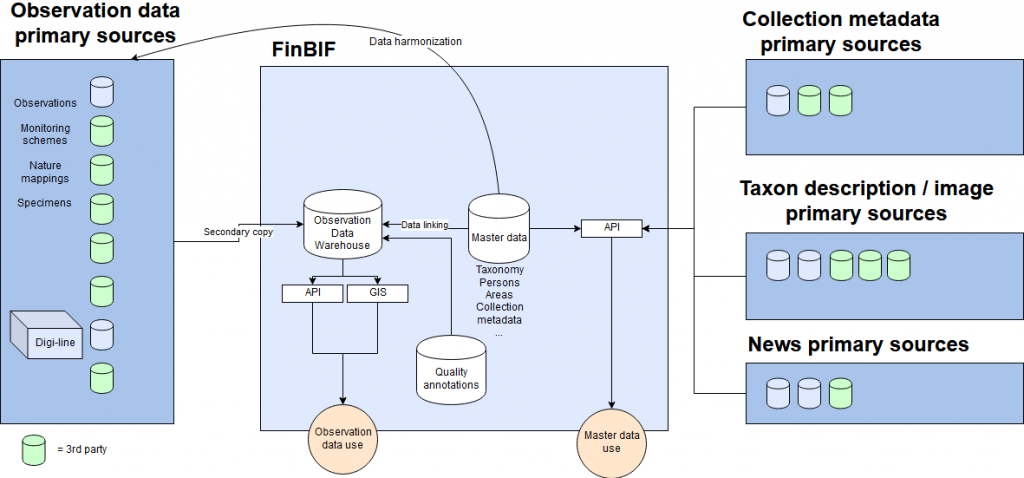Architecture overview
FinBIF architecture has four key goals:
- Harvest and share occurrence data from Finland and surrounding areas
- Maintain and share a taxonomic backbone of Finnish species
- Provide a highly customizable observation system
- Provide a collection management and digitizing system for Finnish natural history collections
Besides these we have services that allows us to:
- Maintain metadata about occurrence data sources/datasets/collections
- Provide a service for occurrence data quality control (annotation system)
- Enrich taxonomic data with descriptions and images, perform Red List evaluations, etc
- Provide a media service for occurrence and taxon images (in future for audio and possibly video)
- Harvest and share news
- Share occurrence data to GBIF
- Provide geospatial tools such as map services
Data and data sources

Occurrence data
FinBIF maintains two primary sources for occurrence data: Vihko Notebook observation system and Kotka collection management system. Besides these, occurrence data are harvested from various other primary sources (observation databases) in and around Finland.
FinBIF Data Warehouse harvests occurrence data and stores it as secondary data. Secondary data is not maintained or owned by FinBIF. All corrections to the data are made in the primary source.
FinBIF does however maintain a quality control annotation system that stores information about the occurrences. The annotation database is a primary source.
In the Data Warehouse, occurrence primary data, quality annotations, taxonomic backbone, area and person information are joined together to provide a query service for occurrence data. On top of this data we have build an API and a QGIS plugin.
There are various ways on how data is harvested from primary sources into the Data Warehouse. These are covered in the Data Warehouse subsection of this document.
Each occurrence dataset must have metadata that describes, for example, the name, type, and owner of the dataset. FinBIF Kotka collection management system provides a metadata database. In the future, it is possible that dataset metadata can also be harvested from metadata databases of FinBIF partner organizations.
Taxon data
FinBIF provides a Taxon editor tool for Finnish taxonomy specialists. The specialists use the tool to maintain their own, expert-validated view of Finnish species.
This data is used as a backbone taxonomy for all FinBIF services.
Taxonomic data is enriched with description texts, images, and other information, some of which is maintained in the Taxon editor and some are harvested from external sources.